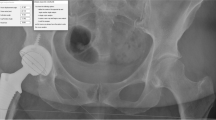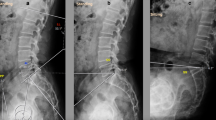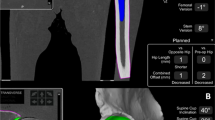Abstract
Purpose
The modified anterolateral approach (Röttinger) for total hip arthroplasty (THA) offers great advantages over conventional approaches, especially concerning early postoperative symptoms, which are mild and well tolerated by patients. Robotic-assisted implantation might facilitate rapid adoption of the modified anterolateral approach without exposing surgeons to risks encountered during the learning curve. This study posits that the use of robotic assistance in conjunction with the modified anterolateral approach for total hip arthroplasty (THA) can provide a substantial enhancement in the accuracy of cup placement in comparison to manual surgery.
Methods
Thirty-two robotic-assisted THAs met the inclusion criteria and were matched to 32 conventional cases. Acetabular cup inclination, anteversion, limb-length discrepancy, and acetabular offset were assessed using certified planning software by two independent observers using pre- and postoperative anterior–posterior radiographs. Data was analyzed for normal distribution. Chi2 test was used to determine whether implanted acetabular cups that were within Lewinnek’s safe zones were influenced by type of implantation. Effect size estimates and statistical power analysis were also performed to appreciate the appropriateness of the chosen sample size.
Results
Robotic-assisted implantation was found to significantly improve acetabular cup placement in terms of inclination (p < 0.001) but not anteversion (p = 0.783). Although mean postoperative limb-length discrepancy and mean acetabular offset did not differ between groups, a significantly smaller variance was found in the robotic-assisted group (p < 0.001) and (p = 0.04), respectively. There were no significant differences between the two groups in terms of consistently implanting the acetabular cup within the Lewinnek safe zones p = 0.641 for anteversion and p = 0.230 for inclination, respectively.
Conclusions
Our results show that although robotic-assisted acetabular cup implantation performed through the modified anterolateral approach did not significantly differ from conventional implantation, it did offer increased accuracy in cup positioning, acetabular bone preservation, and limb-length restoration.








Similar content being viewed by others
References
Stolarczyk A et al (2022) Analysis of biomechanical gait parameters in patients after total hip replacement operated via anterolateral approach depending on size of the femoral head implant: retrospective matched-cohort study. Arch Orthop Trauma Surg 142(12):4015–4023. https://doi.org/10.1007/s00402-021-04264-6
Fink B, Morgan M, Schuster P (2022) Reconstruction of the anatomy of the hip in total hip arthroplasty with two different kinds of stems. BMC Musculoskelet Disord 23(1):212. https://doi.org/10.1186/s12891-022-05152-9
Sariali E, Klouche S, Mouttet A, Pascal-Moussellard H (2014) The effect of femoral offset modification on gait after total hip arthroplasty. Acta Orthop 85(2):123–127. https://doi.org/10.3109/17453674.2014.889980
Shaw JH, Rahman TM, Wesemann LD, Jiang CZ, Lindsay-Rivera KG, Davis JJ (2022) Comparison of postoperative instability and acetabular cup positioning in robotic-assisted versus traditional total hip arthroplasty. J Arthroplasty 37(8):S881–S889. https://doi.org/10.1016/j.arth.2022.02.002
Foissey C et al (2023) Image-based robotic-assisted total hip arthroplasty through direct anterior approach allows a better orientation of the acetabular cup and a better restitution of the centre of rotation than a conventional procedure. Int Orthop 47:691–699. https://doi.org/10.1007/s00264-022-05624-6
Di Martino A et al (2023) How to perform correct templating in total hip replacement. Musculoskelet Surg 107:19–28. https://doi.org/10.1007/s12306-023-00772-3
Malik A, Maheshwari A, Dorr LD (2007) Impingement with total hip replacement. J Bone Joint Surg Am 89(8):1832–1842. https://doi.org/10.2106/JBJS.F.01313
Tezuka T, Heckmann ND, Bodner RJ, Dorr LD (2019) Functional safe zone is superior to the Lewinnek safe zone for total hip arthroplasty: why the Lewinnek safe zone is not always predictive of stability. J Arthroplasty 34(1):3–8. https://doi.org/10.1016/j.arth.2018.10.034
Abdel MP, von Roth P, Jennings MT, Hanssen AD, Pagnano MW (2016) What safe zone? The vast majority of dislocated THAs are within the Lewinnek safe zone for acetabular component position. Clin Orthop 474(2):386–391. https://doi.org/10.1007/s11999-015-4432-5
Ando W, Takao M, Hamada H, Uemura K, Sugano N (2021) Comparison of the accuracy of the cup position and orientation in total hip arthroplasty for osteoarthritis secondary to developmental dysplasia of the hip between the Mako robotic arm-assisted system and computed tomography-based navigation. Int Orthop 45(7):1719–1725. https://doi.org/10.1007/s00264-021-05015-3
Kobayashi H et al (2020) Pre-operative templating in THA. Part II: a CT-based strategy to correct architectural hip deformities. Arch Orthop Trauma Surg 140(4):551–562. https://doi.org/10.1007/s00402-020-03341-6
Terrier A, Levrero Florencio F, Rüdiger HA (2014) Benefit of cup medialization in total hip arthroplasty is associated with femoral anatomy. Clin Orthop 472(10):3159–3165. https://doi.org/10.1007/s11999-014-3787-3
Vandenbroucke JP et al (2007) Strengthening the reporting of observational studies in epidemiology (STROBE): explanation and elaboration. Ann Intern Med 147(8):W163. https://doi.org/10.7326/0003-4819-147-8-200710160-00010-w1
Maillot C, Harman C, Villet L, Cobb J, Rivière C (2019) Modern cup alignment techniques in total hip arthroplasty: a systematic review. Orthop Traumatol Surg Res 105(5):907–913. https://doi.org/10.1016/j.otsr.2019.03.015
Domb BG et al (2015) Accuracy of component positioning in 1980 total hip arthroplasties: a comparative analysis by surgical technique and mode of guidance. J Arthroplasty 30(12):2208–2218. https://doi.org/10.1016/j.arth.2015.06.059
Domb BG, El Bitar YF, Sadik AY, Stake CE, Botser IB (2014) Comparison of robotic-assisted and conventional acetabular cup placement in THA: a matched-pair controlled study. Clin Orthop 472(1):329–336. https://doi.org/10.1007/s11999-013-3253-7
Delagrammaticas DE, Ochenjele G, Rosenthal BD, Assenmacher B, Manning DW, Stover MD (2020) Intraoperative evaluation of acetabular cup position during anterior approach total hip arthroplasty: are we accurately interpreting? HIP Int 30(1):40–47. https://doi.org/10.1177/1120700019868665
Cech A et al (2020) Pre-operative planning in THA. Part III: do implant size prediction and offset restoration influence functional outcomes after THA? Arch Orthop Trauma Surg 140(4):563–573. https://doi.org/10.1007/s00402-020-03342-5
Bonnin MP, Archbold PHA, Basiglini L, Fessy MH, Beverland DE (2012) Do we medialise the hip centre of rotation in total hip arthroplasty? Influence of acetabular offset and surgical technique. HIP Int 22(4):371–378. https://doi.org/10.5301/HIP.2012.9350
Hu X et al (2020) Adverse effects of total hip arthroplasty on the hip abductor and adductor muscle lengths and moment arms during gait. J Orthop Surg 15(1):315. https://doi.org/10.1186/s13018-020-01832-1
Guo D, Li X, Ma S, Zhao Y, Qi C, Xue Y (2022) Total hip arthroplasty with robotic arm assistance for precise cup positioning: a case-control study. Orthop Surg 14(7):1498–1505. https://doi.org/10.1111/os.13334
Hardwick-Morris M, Wigmore E, Twiggs J, Miles B, Jones CW, Yates PJ (2022) Leg length discrepancy assessment in total hip arthroplasty: is a pelvic radiograph sufficient? Bone Jt Open 3(12):960–968. https://doi.org/10.1302/2633-1462.312.BJO-2022-0146.R1
Konyves A, Bannister GC (2005) The importance of leg length discrepancy after total hip arthroplasty. J Bone Joint Surg Br 87B(2):155–157. https://doi.org/10.1302/0301-620X.87B2.14878
Song SK, Choi WK, Jung SH, Kim HC, Kim TH, Cho MR (2021) Changes of acetabular anteversion according to pelvic tilt on sagittal plane under various acetabular inclinations. J Orthop Res 39(4):806–812. https://doi.org/10.1002/jor.24790
Author information
Authors and Affiliations
Corresponding author
Additional information
Publisher's note
Springer Nature remains neutral with regard to jurisdictional claims in published maps and institutional affiliations.
Rights and permissions
Springer Nature or its licensor (e.g. a society or other partner) holds exclusive rights to this article under a publishing agreement with the author(s) or other rightsholder(s); author self-archiving of the accepted manuscript version of this article is solely governed by the terms of such publishing agreement and applicable law.
About this article
Cite this article
Avram, G.M., Prill, R., Gurau, C.D. et al. Acetabular cup placement and offset control in robotic total hip arthroplasty performed through the modified anterolateral approach. International Orthopaedics (SICOT) 47, 2265–2273 (2023). https://doi.org/10.1007/s00264-023-05835-5
Received:
Accepted:
Published:
Issue Date:
DOI: https://doi.org/10.1007/s00264-023-05835-5




